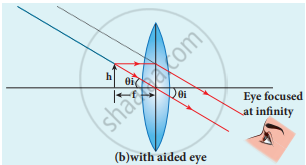Advertisements
Advertisements
Question
Discuss about simple microscope and obtain the equations for magnification for near point focusing and normal focusing.
Answer in Brief
Solution
- A simple microscope is a single magnifying (converging) lens of small focal length.
- The idea is to get an erect, magnified and virtual image of the object. For this the object is placed between F and P on one side of the lens and viewed from other side of the lens.
- Near point focusing:
The image is formed at a near point, i.e. 25 cm for the normal eye. This distance is also called as least distance D of distinct vision. In this position, the eye feels comfortable but there is little strain on the eye. - Normal focusing:
The image is formed at infinity. In this position, the eye is most relaxed to view the image.
Magnification in near point focusing:
- Object distance u is less than f. The image distance is the near point D. The magnification m is given by the relation,
m = `"v"/"u"` - The magnification can further be written as,
m = `1 - "v"/"f"`(using lens equation)
Substituting for ν with sign convention,
v = - D
m = `1 + "D"/"f"`
This is the magnification for near-point focusing.
Near point focusing
Magnification in normal focusing (angular magnification):
- The magnification for the image is formed at infinity.
- The angular magnification is defined as the ratio angle θi, subtended by the image with an aided eye to the angle θ0 subtended by the object with unaided eye.
m = `theta_"i"/theta_0`

Normal focusing
For unaided eye
tan θ0 ≈ θ0 = `"h"/"D"`
For aided eye
tan θ0 ≈ θ0 = `"h"/"f"`
The angular magnification is,
m = `theta_"i"/theta_0 = ("h"//"f")/("h"//"D")`
m = `"D"/"f"`
This is the magnification for normal focusing.
shaalaa.com
Optical Instruments
Is there an error in this question or solution?
